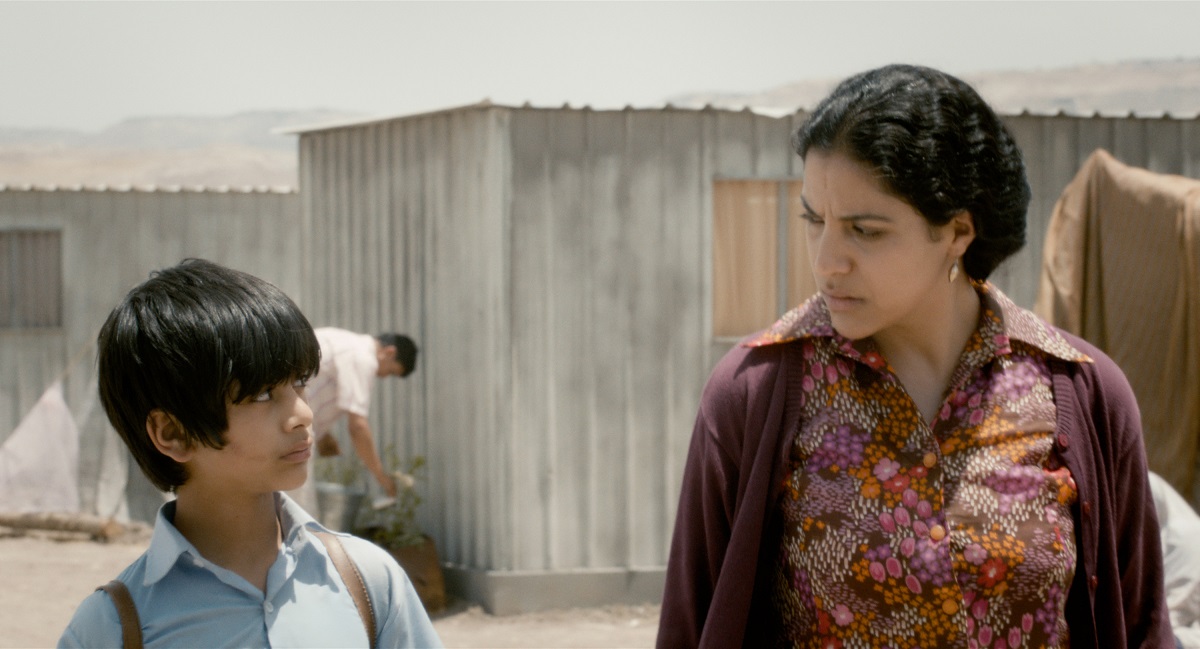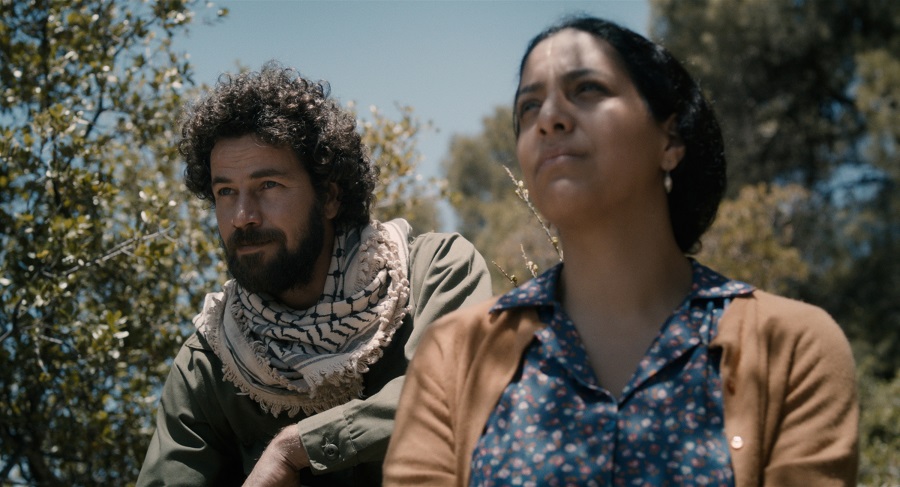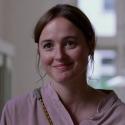In 2007 Annemarie Jacir made her debut feature, Salt of This Sea, the first film directed by a Palestinian woman director. Her follow-up, When I Saw You, is released this week in the UK, after festival acclaim that saw it receive prizes at Berlinale 2012 (the Netpac award for “Best Asian Film”) and “Best Arab Film” at the Abu Dhabi Film Festival. The story of a boy coming of age in a refugee camp in Jordan in 1967, and his complex relationship with his mother and his surroundings, it was the Palestinian submission for the 2013 Best Foreign Language Film Oscar.
Jacir's short films have been winning acclaim at Cannes and other festivals over the last decade, but she began working in the theatre, first in set design and then writing and directing plays. She is a co‐founder of Philistine Films, which focuses on productions related to the Arab world, and a project particularly dear to her heart is "Dreams of a Nation", dedicated to the conservation and promotion of the cinema of her native land. In 2003, she organized and curated the largest travelling film festival in Palestine, which included the screening, for the first time on its soil, of archival Palestinian films. Along with her work as a filmmaker, she is also a poet, a film curator and a lecturer in filmmaking, including at refugee camps in Palestine, Lebanon and currently in Jordan.
Jacir will be in London at the end of this week to present When I Saw You, but in advance she answered theartsdesk’s questions about the historical context of the film, the experience of working with the film’s remarkable actors, professional and non-professional alike, and Palestine’s cinema heritage, by email from Amman, Jordan, where she has been based for the last five years.
TOM BIRCHENOUGH: What are the personal resonances for you of the film’s title, When I Saw You?
I wrote the script when I was exiled from Palestine and I was forbidden from returning
ANNEMARIE JACIR: I wrote the script when I was exiled from Palestine and I was forbidden from returning. Suddenly I found myself in the position of the majority of Palestinians, seeing my homeland from across a border. For me, the title refers to a moment in a person’s life where things change and they see something or someone for the first time, whether they have seen it a million times already. Except this time they are truly seeing, as if for the first time.
And from that “seeing” an idea or energy emerges from within. What you see could be your homeland or it could be a person, a loved one... There is a lot of “seeing” that happens in the film. Sometimes “seeing” means seeing your own life for what it is, or what it could be. The moment you understand something that you didn’t before. Sometimes something is right in front of you but you don’t see it. Or at least you don’t see the possibilities. And then you may decide to act on it.
 You draw an astonishing performance from Mahmoud Asfa as Tarek, the non-professional lead role? How did you find him, and how did you cast the film, in general?
You draw an astonishing performance from Mahmoud Asfa as Tarek, the non-professional lead role? How did you find him, and how did you cast the film, in general?
Thank you. It took a long time to find Mahmoud (pictured, above). We visited community centres, schools, refugee camps, and theatres. We saw about 200 boys until we found him in Irbid refugee camp in the north of Jordan. Right away he won my heart. He’s bright and generous and I knew I could work with him. Ruba Bala, who plays the mother, and is a professional actor, was someone I was hoping to work with. But I had to find Tarek first and then hope they would fit – and they did, brilliantly. Saleh Bakri (with Ruba Bala, pictured, bottom left) I cast for my first feature Salt of This Sea when he was still new, and I respect him as an artist very much. It was a nice reunion. As for the others, they are a mix of non-professionals and theatre actors. Many of the fedayee are the children of actual fedayee, which brought a great richness to our work together and to the film.
How did Mahmoud interact with the professional actors, especially the character of his mother, the no-less outstanding Ruba Blal?
I was very lucky to have found Mahmoud. He has a great amount of patience and his mind is open, always wanting to learn. Ruba’s experience is definitely something that was a bonus for him, and he was eager to learn from her as well. For the months leading up to production, I asked Ruba and Mahmoud (pictured, below right) to spend time together, wander the city, eat together, and do just normal everyday things to build up that mother-son relationship.
How much did improvisation enter the process of filming? With a child actor who leads by his gestures and eyes, did you stick to the script?
We stuck to the script completely. However, I never let Tarek read the script. Instead in the months before filming, I worked with Tarek on building his entire world before the story of the film begins. Meaning, we worked on creating his village Bayt Nuba, his relationship to his mother, to his father, to his school. Every single detail of his life. For example, I had him draw maps of his family home, had him come up with each item that would be in each closet, in the kitchen, in the fridge, etc. When we began filming, he understood he was a refugee and had lost all those things he knew. He was in a new space now and had to deal with that. During production, he would receive his scenes only a day or two beforehand.
 You catch a moment when a traditional, though dislocated, world encounters modernity? How did Jordan accept the refugees at the time? How did you research their testimonies?
You catch a moment when a traditional, though dislocated, world encounters modernity? How did Jordan accept the refugees at the time? How did you research their testimonies?
For this film, research was key, especially as I did not live in the time period. I collected hundreds of images and footage from people, organizations, and film archives. The writings of Kanafani, books like Genet’s memoir and others. Documentaries, archival photos and films were crucial to “see” the look of the refugee camp, the people, and also the fighters. Aside from the UNWRA archives, I had access to the films of the Palestinian revolutionary cinema. Twelve years ago I was part of a project which set out to find the lost Palestinian archives and have collected throughout the years many of those films whose images I tried to make reference to in When I Saw You. Each party had a film unit that was mostly making propaganda films, but also were simply documenting their daily lives, training sessions, and the camps. I also conducted several interviews, mostly in Jordan, with people who were involved in the resistance. Of course, there were larger questions but also questions like, “What brand of cigarettes did you smoke?”, “What was your favourite song?”….
Speaking of music, that’s a good example of a traditional world encountering another one. In the late 1960s the Palestinians were very much connected to what was happening all over the world – they were listening to Arabic classics and also creating a new kind of music, influenced from both their East and their West, and pushing boundaries, as in their own lives. I worked with long-time collaborator Kamran Rastegar on the original track and also researched and discovered a lot of obscure musicians and bands of the time: Lebanese rock, Armenian fusion, Egyptian jazz, Moroccan avant-garde Gnawa, some really fun stuff, and that is what we hear on the radio most of the time in the film – other than the constant news broadcasts. In terms of the film’s live music, the first piece, around the fire, is an original song written for the film, sung by Ruba Shamshoum, a new jazz singer. There was a certain magic in the time before TVs and computers, and when people were together they would sing. I wanted to break the rhythm of the film with this unusually long sequence, to change the pace so we would linger on the faces of these young men and women, each with their own stories, depth, nostalgia, madness; people so famously absent from the media normally. The second piece which leads into the dancing is one of the most famous Palestinian resistance songs, “Akka’s Prison,” written in 1930 against British rule, as a commemoration to three men who were hung, and a call to continue the struggle for freedom.
How did you work on the colour of the film with your cinematographer Hélène Louvart? You move from a “bleached”, dry colour in the camp and the desert, to something much richer in the hills – the greens and the blues kick in? And there’s always that deep red of Tarek’s t-shirt.
Those poppies are always a sign of Spring in Palestine and Jordan and cover the hillsides
My collaboration with Hélène was very special. Hélène understood the script and the story deeply and we had a real meeting of the minds. We spoke about the story and the characters endlessly. I showed her images, colours, photographs, and films that I liked, that I was inspired by artistically, as well as archival images. We watched a lot of footage together from the time period, and specifically of the Palestinian refugee camps as well as training camps, in order to design the look of When I Saw You. I wanted to create a look which was fresh and fantastical at times, but also giving hints to the harsh reality which fantasy escapes from. And also to pay cinematic homage to the period, one of the reasons for the freeze-frame at the end. For the colours, we specifically wanted to have two different palettes in the refugee camp and in the training camp. And in addition to that, the colours change according to whether we are in Tarek’s dreamy, fantasy mode versus when a scene should be more realistic.
Colours are also a repeated theme in the film. Several scenes begin either with red, black, white or green. The colours of the Palestinian flag, of course. It was a way to reflect the rise of this national movement as well as Tarek’s own identity and his politicization. The colours are again repeated in the song that Ruba Shamsoum sings the first night around the fire. She mentions the red poppies as well. Those poppies are always a sign of Spring in Palestine and Jordan and cover the hillsides. It’s the most beautiful thing. I wanted Tarek to be in red for that reason, too.
What is the “aesthetic” that charges your film-making? You have studied in the States, this film is partly backed out of Europe, its texture is so influenced by cinematographer Hélène Louvart, and it won the “Best Arab Film” at Abu Dhabi? Where, if you can define it, is your “film territory”?
 The production of the film is entirely Arab-financed, in fact – with all Palestinian producers. I believe it’s the first Palestinian film which is entirely Arab-financed. My first feature Salt of This Sea was exactly the opposite. I had no Arab money, and it was made as a co-production with eight different countries, mostly European.
The production of the film is entirely Arab-financed, in fact – with all Palestinian producers. I believe it’s the first Palestinian film which is entirely Arab-financed. My first feature Salt of This Sea was exactly the opposite. I had no Arab money, and it was made as a co-production with eight different countries, mostly European.
I lived the first 16 years of my life in Saudi Arabia, splitting my time between Riyadh and our hometown, Bethlehem. Then I moved to the US, living in various cities, as well as in Europe, and finally moving to Palestine. I’ve spent the last five years in Amman. I’ve always been between many countries, cities, and I guess that does affect my aesthetic somehow. I don’t know. I’m comfortable anywhere in the world really, and feel inspired by so many different kinds of cinemas and peoples.
Is the Palestinian film industry today a united, or disparate entity? What brings you together, even in diaspora?
Many of us collaborate together. But what really unites us is our shared history. I think Palestinian cinema had a brief moment where it was very “fashionable” about six years ago, in the same way that all cinemas all over the world have this moment. It comes and it goes. There are certainly now more filmmakers working than ever before, and that’s always a good thing.
Why “Philistine Films” as the name of your production company?
I chose that name because I liked the play on words. “Philistine” in Arabic sounds like the word for “Palestine”. And of course the Philistines of the bible. And in English, I love the meaning: artless and culture-less. An insult. It’s a tongue-in-cheek name for the company.
You leave the ending very much open – where would Tarek be today, nearly half a century on?
This film intentionally does not extend further than the time period it takes place in, 1967-1968. Everyone knows very well what happens next – Black September, in-fighting, splinter movements, corruption, the horrid Oslo process. So many things went wrong. So many dreams were stolen. I wanted to give a hint of that in When I Saw You. You feel an undercurrent of in-fighting, egos starting to take shape amongst the fighters, different ideas forming. But the film is only about the moment before that. I leave it to you to tell me where you think Tarek is at 50.
What is your current experience of working as a woman director in the Arab film world? Are we right to feel a sense of emerging talents and changing circumstances?
Absolutely! There is something very, very exciting happening, especially with women filmmakers who tend to work with different conditions. Not just in the Arab world, but with independent cinema all over the world. Women have traditionally been left out of the mainstream system, and their abilities questioned and doubted more, especially in places with a long history of cinema such as the United States or France. However I believe that is changing, and I definitely think Arab women are at the forefront of a changing movement.
Overleaf: watch the trailer to When I Saw You














Add comment